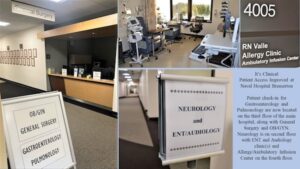
Story by Douglas Stutz
Naval Hospital Bremerton/Navy Medicine Readiness and Training Command Bremerton
In a flurry of moves designed to improve patient access, Naval Hospital Bremerton has relocated several clinics inside the main hospital.
The buzzword phrase is space utilization as the Defense Health Agency military treatment facility strives to optimize existing clinical areas to appropriately align the capabilities of NHB to eliminate redundancy, generate greater clinical efficiency, and improve the patient experience.
Patients can now check-in for appointments for Gastroenterology – which focuses on the digestive systems and its disorders – and Pulmonology – Internal Medicine specialty of the respiratory system – clinics on the third floor of NHB with General Surgery.
Appointments for the OB/GYN – medical care specializing in female reproductive health – clinic are also being handled at the General Surgery desk.
“The realignment of spaces coupled with new organizational structure allow for an improved patient experience with co-location leading to improved patient access to clinics versus clinics being geographically dispersed through the facility,” said Cmdr. Brandon K. Wolf, director for strategy and operations and department head for specialty care.
Wolf noted that NHB, as the rest of DHA, has experienced tremendous change over the past decade, including the need to consolidate resources due to reduced capabilities and reduction in staff.
“The reorganization of the Directorate for Medical Services and Directorate for Surgical Services chain of command into a single directorate, Directorate for Health Services, is predicated on varied changes which has transformed NHB from a 24-hour inpatient military treatment facility to primarily an outpatient community hospital providing ambulatory surgical center services. This transformation is coupled with requirements to standardize staffing models, improve workforce management, and meticulously account for budgetary resources,” explained Wolf.
Expected benefits from the realignment include being able to fully maximize the potential of the clinics to serve the patient population.
“This initiative aims to align processes which will enable NHB to achieve a streamlined management structure, eliminate redundancy and generate greater effectiveness, yield monetary savings, in addition to improving patient safety, quality, delivery (outcomes), and affordability by integrating requirements, resources, and program decisions,” stated Wolf.
“Aligning staff to concentrated clinical areas allows for greater clinic efficiency,” Wolf continued. “It allows us to cross-train staff in multiple clinics setting which they may not have the benefit to work in, leading to increased skill sustainment and attainment.”
NHB also relocated the Neurology – nervous system diagnosis and treatment – Clinic to the second floor in the Ears, Nose and Throat [Otorhinolaryngology] and Audiology clinic(s).
Additional plans for consolidating services included embedding population health nurses and incorporating the Coumadin Clinic – treating or preventing blood clots in veins/arteries – with Internal Medicine.
NHB handled approximately 4,730 Internal Medicine visits last year, with more than 1,000 neurology appointments, over 640 gastroenterology and nearly 270 endoscopy appointments.
The first phase was placing the Allergy Clinic and Ambulatory Infusion Center on the fourth floor next to the Ambulatory Procedure Unit with increased access and support from anesthesia providers.
The clinic movement is in the same building, in some cases just several floors from the old locale to new location, with all rearrangements centered on improving efficiency and experience.
“Staff have had to relocate from spaces that they have been accustomed to. All staff, civil service, active duty and contractor, have been amazing in their ability to adapt and provide significant input how process can be improved for clinical efficiency and the patient experience. From an active-duty standpoint, the greatest advantage is the experiences the personnel will be able to obtain in multiple clinical areas,” remarked Wolf.
The mission remains the same in keeping warfighters – and their families – ready, healthy and on the job.
“We are in some ways breaking with tradition and the way things have always been. It’s been both challenging and rewarding. We have gotten to interact and work with an amazing group of professionals who took on the challenges [to timely move material and manpower] and made them a reality,’ Wolf said.